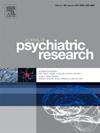Are adolescent males or females more proficient self-raters of symptoms of Attention-Deficit/Hyperactivity Disorder?
IF 3.2
2区 医学
Q1 PSYCHIATRY
引用次数: 0
Abstract
Objectives
The current study examined the relation between self-rated and parent- and clinician-rated symptoms of Attention-Deficit/Hyperactivity Disorder (ADHD), by estimating rater agreement and rater differences, and whether these differed between the sexes.
Method
The sample included N = 159 adolescents with ADHD aged 15–18 years (Mage = 16.59 years, SD = .92) of which n = 58 (36.5 %) were males. Symptoms were assessed using self- and parent-ratings with the adult ADHD Self-Report Scale for Adolescents, whereas clinicians rated symptoms using the Mini International Neuropsychiatric Interview for children and adolescents conducted with the adolescents and their parent. We used intra-class correlation coefficients (ICC) to assess rater agreement and t-tests to assess differences.
Results
Males rated fewer symptoms compared to their parents and clinicians, whereas females’ self-ratings did not differ from parent and clinician ratings. Relatedly, females were in higher agreement with parents and clinicians compared to males. Females had a higher symptom severity than males in self-ratings and clinician-ratings, but not in parent-ratings. Adolescents were in higher agreement with clinicians than parents.
Conclusions
Our results indicate that adolescent males with ADHD may underestimate their symptoms whereas females may have more insight into their symptoms when compared to other raters. Adolescents are important raters of their own ADHD symptoms and their perspectives need to be taken into account in diagnostic assessments.
青少年男性或女性对注意力缺陷/多动障碍症状的自我评定更熟练吗?
目的本研究通过估计一致性和差异性,以及这些差异是否在性别之间存在差异,来检验注意力缺陷/多动障碍(ADHD)自评症状与父母和临床医生评估症状之间的关系。方法选取15 ~ 18岁ADHD青少年159例(Mage = 16.59, SD = 0.92),其中男性58例(36.5%)。使用成人ADHD青少年自我报告量表对症状进行自我评定和父母评定,而临床医生使用青少年及其父母对儿童和青少年进行的迷你国际神经精神病学访谈对症状进行评定。我们使用类内相关系数(ICC)来评估评分者的一致性,使用t检验来评估差异。结果与父母和临床医生相比,男性对症状的评价较少,而女性的自我评价与父母和临床医生的评价没有差异。与此相关,与男性相比,女性对父母和临床医生的认同程度更高。在自我评定和临床评定中,女性的症状严重程度高于男性,但在父母评定中没有。青少年对临床医生的认同程度高于父母。结论青少年ADHD男性可能低估了自己的症状,而女性可能比其他评判者更了解自己的症状。青少年是他们自己ADHD症状的重要评分者,在诊断评估中需要考虑他们的观点。
本文章由计算机程序翻译,如有差异,请以英文原文为准。
求助全文
约1分钟内获得全文
求助全文
来源期刊

Journal of psychiatric research
医学-精神病学
CiteScore
7.30
自引率
2.10%
发文量
622
审稿时长
130 days
期刊介绍:
Founded in 1961 to report on the latest work in psychiatry and cognate disciplines, the Journal of Psychiatric Research is dedicated to innovative and timely studies of four important areas of research:
(1) clinical studies of all disciplines relating to psychiatric illness, as well as normal human behaviour, including biochemical, physiological, genetic, environmental, social, psychological and epidemiological factors;
(2) basic studies pertaining to psychiatry in such fields as neuropsychopharmacology, neuroendocrinology, electrophysiology, genetics, experimental psychology and epidemiology;
(3) the growing application of clinical laboratory techniques in psychiatry, including imagery and spectroscopy of the brain, molecular biology and computer sciences;
 求助内容:
求助内容: 应助结果提醒方式:
应助结果提醒方式:


